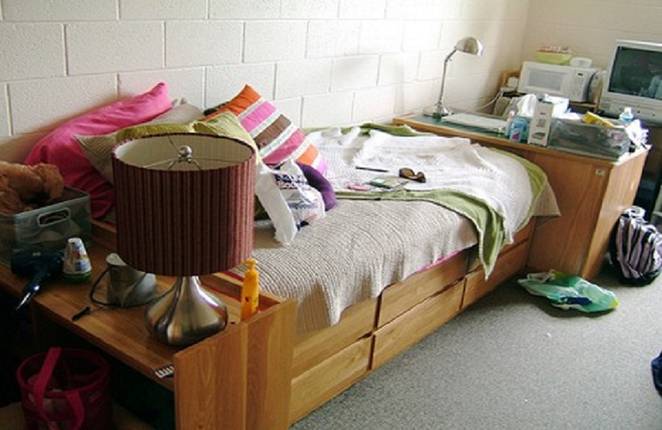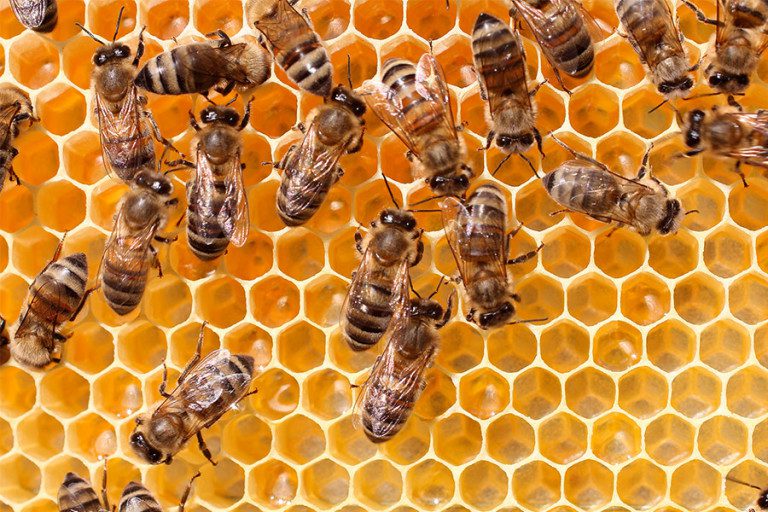Team Treehugger HTGG July 18, 2014
Every year, intrepid young men and women set out for college. Even more exciting than this, is that for many of them, it’s their first chance to live away from home. But, with the excitement and fun of furnishing a new dorm room comes a price. Every year, college students (and their parents) generate thousands of tons of garbage, because of the choices they make in buying furniture and accessories. Luckily, getting your dorm to be green has never been easier. All it takes is a little effort, a little creativity, and a few tips and tricks.
As with most activities, we recommend carefully considering your needs before purchasing anything. Going off to college is one step toward starting a new life as an adult, and it can feel like you need lots of stuff to make it work, so it’s worth your time to vet the list and only go for what you really need. Happily, lots of resources exist to help keep furnishing your new home away from home into an endless search for stuff. And, because lots of people do it every year, there are lots of gently used resources (at greatly reduced prices) out there, waiting for you to snap up and make your own.
Beyond the actual stuff you’ll need, going green in your dorm room is also about adopting a green point of view. For example, instead of loading up on bottled water to help stay hydrated during all-night study sessions, grab a BPA-free water bottle (like a Bilt or Kleen Kanteen) and a tabletop water filter, or a filtering system that you can keep in the fridge. Rather than running extension cords everywhere to power your electronic gear, put them all on power strips, so you can easily keep them from sucking too much phantom power out of the electricity grid. Instead of using plug-in air fresheners, stock up on plants that improve indoor air quality to help keep your room smelling fresh without all that toxic stinky stuff.
Your dorm room is your castle, while you’re at school, at least, so there’s no better time to learn some green lessons that you can apply to living the rest of your green life. Read on for a bounty of ideas and tips for greening your dorm room this year.
Top Green Dorm Room Tips
Keep it local
Many college students want an “away from home” experience. Just don’t make it a “shipping tons of stuff all over the country” experience. If it’s your first year at school, try to obtain your furnishings locally when you get to school (See tips 2 and 3). If you’re a returning student, think about local storage–many schools offer storage options.
- Use the used
Sure, this may be your first home away from home, and we understand the urge to decorate with all the coolest new stuff from Target or WalMart. Just consider, for a second, how much waste that would mean, assuming most freshmen get relatively new stuff every year of school. See what we mean? Instead, why not check out great used sources of stuff, like local resale shops, eBay Local, and Craigslist. You’ll be guaranteed to have a really unique room décor (see tip 10 to max this out), and you’ll have money left over to throw wild parties (Um, we mean library study snacks).
- Capture the free
Of course, while cheap used stuff is good, there is something better: Free used stuff. If you’re a new freshman, check out Craigslist or Freecycle in your area to see if there are any items like beds, desks, or lamps that you can score for free. If you stayed at school over the summer for research or whatnot, your university may have a coordinated furniture recycling day. Or, you might just hang around during move-out and see what you can collect. In many places, you can almost completely furnish apartment by just hanging out around student housing at the end of the school year.
- Condition yourself, not your air
One of the most eco-friendly things you can do as a student is to give up air conditioning. Many universities make it really easy for you to do by banning AC units in dorms. But that doesn’t stop some crafty students from sneaking them in. The trouble is, there are millions of students all over the world, which means the potential for hundreds of thousands of energy-sucking AC units. Instead of AC, why not try opening a window, turning on a fan, taking a cold shower before bed, or studying outside. Of course, if you have to have AC for allergies or some other reason, be sure to get an Energy-Star rated low-energy unit.
- Be sure your fridge is cool
Another big energy-sucker of dorms is the ol’ microfridge. Of course, the best thing you can do is go fridgeless or check into a shared larger fridge (many dorms have shared kitchens with fridges). But if you must have a fridge to yourself, make sure it’s energy-star or other low-energy certified. This can save you 50 percent of the energy use of regular appliances. - Cook it right
You may scoff at the microwave/toaster oven combo, but by combining these two cooking appliances with a cheap rice cooker, you’ve got nearly the perfect eco-kitchen. All three of these appliances boast high energy efficiencies relative to their big-kitchen counterparts.But remember, the best way to cook in a green way is to get social with it. Cooking with friends is cheaper and much more fun. You can experiment with green recipes (we have tons of suggestions) and work out a good system for sharing the burden of buying, cooking and cleaning.
Paper please
- Sure, it’s not the sexiest of materials, but there are plenty of paper options for dorm decor that can be recycled when you out-grow them in a few years. Check out paper wall tiles from MioCulture, paper window treatments from Redi Shade, or make your own paper lampshades.
- See the light
Stick with light emitting diode bulbs. The newer ones put out great light, use just a trickle of electricity, and last almost forever. This is one thing worth buying again every time you move; by leaving them for your next tenant, you’ll be spreading the green love with every new apartment.
- Don’t let the sheets hit the fan
Linens for your new room will make up the bulk of the rest of your buying. When you look for sheets, curtains, or towels, go for organic cotton, if possible. It’s still the same cottony goodness, but you’ll rest easy knowing it’s grown without nasty pesticides. Another option is flax. In general, flax uses less water and fewer pesticides than cotton. If you can, go with organic flax and it’s pesticide free, so it makes for great linen
- Re-used doesn’t have to mean re-pulsive
Just because you got used stuff, doesn’t mean it has to be old and moldy. This is college. You’re supposed to be wild and experimental. So go crazy. Why not try sewing some cushion covers, or pillows for that old couch. Or invite some of your new friends over for a painting party on that old dresser and table. Unleash your inner crafter with great magazines like Make, Craft, or Readymade.
- Learn from camping
When you go camping, you hardly bring anything and yet you get by just fine. Thinking about what you use when you go camping can be a great way to figure out how to cut down on unnecessary items. It makes it easier to move out at the end of the year – you won’t have as much clutter! Camping also teaches you how to go portable. We all know how cramped dorm rooms can be, so consider portable transformer furniture. It folds away and is really easy to use.
- Look for a green dorm
More and more colleges are offering green dorms. They can have composting toilets, be made from recycled materials, and use geothermal heating. Do some research and find out if your college offers any.


Green Dorm Rooms: By the Numbers
- 20 percent: Estimated reduction in energy use at Stanford’s Lotus Living Laboratory green dorms.
- $18.95: Estimated savings per student, over the course of a year, for Tulane’s Energy Star Showcase Dorm Room.
- $61,728.40: Estimated annual savings that Tulane would realize if every dorm room matched the performance of the Energy Star Showcase room.
- 968,073: Pounds of CO2 Tulane could save annually by creating Energy Star dorm rooms across campus.
- 30 percent: Estimated reduction in both energy and water use at Tufts University’s Sophia Gordon Hall, the university’s first green dorm building that opened in 2006.
- 47 percent: Amount of energy used on lighting at Macalester University, making lighting the largest consumer of electricity in their dorms.
- 102 Watts: Size of the solar panel that University of Vermont student Ross Nizle purchased to help take his dorm room off the grid.
- 25,000 pounds: Estimated amount of reusable goods kept out of landfills by this year’s inaugural “Green Apple Move Out” event at NYU.
Sources: Stanford’s Lotus Living Laboratory, Energy Star, Tulane University, Tufts University, Macalester University, University of Vermont, New York University
Green Dorm Rooms: Getting Techie
Why are microwaves and crockpots so good?
Cooking options like microwave ovens, toaster ovens, crock pots, and rice cookers concentrate the heat in the food, instead of heating so much extra air, or metal like conventional ovens and frying pans do. Electric grills are also heavy-duty energy users because they operate at such high temperatures (this also makes them fire hazards, and banned by many dorms). The lowest energy way to a meal is to think about what you need heated up, and what tool best to heat it with. Microwaves heat evenly throughout the food, especially if it is wet, like mashed potatoes, boiling water, or meat. Toaster ovens are really good at browning the surface of food (try cooking chicken or steak part way in a microwave and then browning in a toaster oven. It’s super fast, and delicious). Rice cookers are great for rice, or rice and frozen vegetables, and some of them come with attachments to steam veggies like broccoli at the same time. Crock pots are a whole other kind of cooking, but with practice, and a good cookbook, they can be the easiest and tastiest kind of food preparation, especially for a time-crunched student.EPEAT: Electronic Product Environmental Assessment Tool
EPEAT is a standard system for evaluating, certifying and registering green computers and other electronics. EPEAT provides a clear and consistent set of performance criteria for the design of products, and provides an opportunity for manufacturers to secure market recognition for efforts to reduce the environmental impact of its products. The rating system evaluates computer and other electronic products according to three tiers of environmental performance — Bronze, Silver, and Gold. There are 51 total environmental criteria: 23 required and 28 optional criteria, and products earn respective labels for the total number of criteria met.
Climate-neutral campuses
The American College and University Presidents’ Climate Commitment, or ACUPCC, is an effort to address greenhouse gas emissions on college campuses across the country. By signing the climate commitment, each university is pledging to work toward climate neutrality, eliminating their contributions to global warming over time. To date, more than 500 colleges and universities in all 50 states have signed the Commitment; together, signatories enroll more than 25 percent of college students in the country.
With reporting by Manon Verchot







